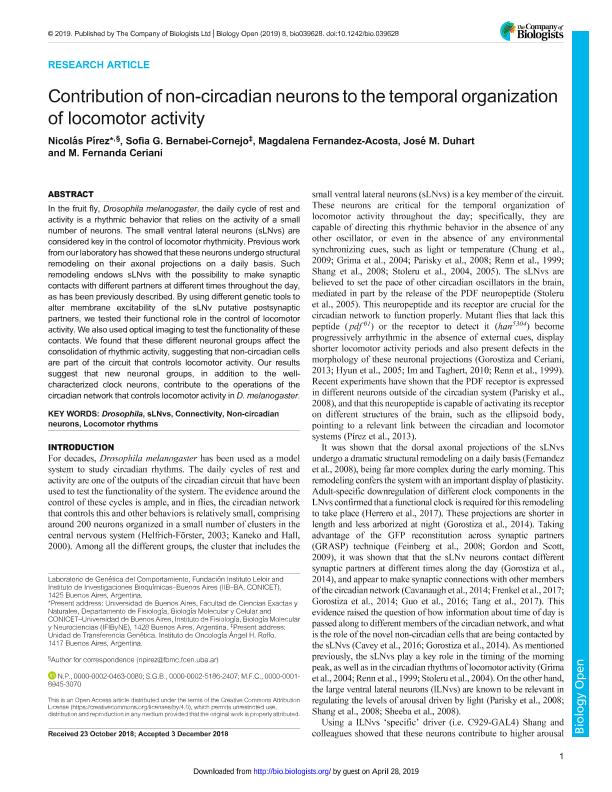Artículo
Contribution of non-circadian neurons to the temporal organization of locomotor activity
Pírez, Nicolas ; Bernabei Cornejo, Sofia Gala
; Bernabei Cornejo, Sofia Gala ; Fernández Acosta, Magdalena
; Fernández Acosta, Magdalena ; Duhart, José Manuel
; Duhart, José Manuel ; Ceriani, Maria Fernanda
; Ceriani, Maria Fernanda
 ; Bernabei Cornejo, Sofia Gala
; Bernabei Cornejo, Sofia Gala ; Fernández Acosta, Magdalena
; Fernández Acosta, Magdalena ; Duhart, José Manuel
; Duhart, José Manuel ; Ceriani, Maria Fernanda
; Ceriani, Maria Fernanda
Fecha de publicación:
01/2019
Editorial:
Company of Biologists
Revista:
Biology Open
ISSN:
2046-6390
Idioma:
Inglés
Tipo de recurso:
Artículo publicado
Clasificación temática:
Resumen
In the fruit fly, Drosophila melanogaster, the daily cycle of rest and activity is a rhythmic behavior that relies on the activity of a small number of neurons. The small ventral lateral neurons (sLNvs) are considered key in the control of locomotor rhythmicity. Previous work from our laboratory has showed that these neurons undergo structural remodeling on their axonal projections on a daily basis. Such remodeling endows sLNvs with the possibility to make synaptic contacts with different partners at different times throughout the day, as has been previously described. By using different genetic tools to alter membrane excitability of the sLNv putative postsynaptic partners, we tested their functional role in the control of locomotor activity. We also used optical imaging to test the functionality of these contacts. We found that these different neuronal groups affect the consolidation of rhythmic activity, suggesting that non-circadian cells are part of the circuit that controls locomotor activity. Our results suggest that new neuronal groups, in addition to the well-characterized clock neurons, contribute to the operations of the circadian network that controls locomotor activity in D. melanogaster.
Palabras clave:
CONNECTIVITY
,
DROSOPHILA
,
LOCOMOTOR RHYTHMS
,
NON-CIRCADIAN NEURONS
,
SLNVS
Archivos asociados
Licencia
Identificadores
Colecciones
Articulos(IFIBYNE)
Articulos de INST.DE FISIOL., BIOL.MOLECULAR Y NEUROCIENCIAS
Articulos de INST.DE FISIOL., BIOL.MOLECULAR Y NEUROCIENCIAS
Articulos(IIBBA)
Articulos de INST.DE INVEST.BIOQUIMICAS DE BS.AS(I)
Articulos de INST.DE INVEST.BIOQUIMICAS DE BS.AS(I)
Citación
Pírez, Nicolas; Bernabei Cornejo, Sofia Gala; Fernández Acosta, Magdalena; Duhart, José Manuel; Ceriani, Maria Fernanda; Contribution of non-circadian neurons to the temporal organization of locomotor activity; Company of Biologists; Biology Open; 8; 1; 1-2019; 1-13
Compartir
Altmétricas



